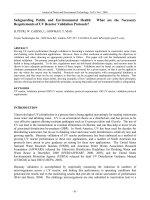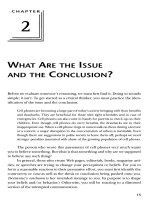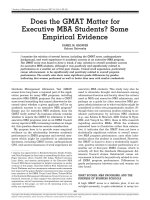pleasantville and american acceptance what does the changing in pleasantville represent in american so
Bạn đang xem bản rút gọn của tài liệu. Xem và tải ngay bản đầy đủ của tài liệu tại đây (38.71 KB, 2 trang )
What do people think of when they hear the name "America?" Do they picture a happily diverse
nation where everyone wants a flawless body, an affectionate family, and endless amounts of
money? Or do they appreciate America's long, rich history of war after war, struggle after struggle
and see that this nation continues in this pattern to present day? Maybe people see it as a country
where the freedom of expression really holds true. To put a definite label on our society's vocal
tendencies and insatiable desires is difficult, so we encompass it all by cramming it into the name
"America." However, America was not always a place where freely expressed emotions were as
welcomed as they are now.
If people are satisfied with the way their lives are going, then they will not make it a point to
change anything. By doing so, they would run the risk of altering their ideal lifestyle. The world is
not a static environment, though. With the constant interactions of people and the advancement of
ideas, it is impossible to keep things the same for even a few seconds. Gary Ross' Pleasantville
examines people's reactions to change in their comfortable way of life, and parallels America's
experience with racism and the world's experience with anti-Semitism.
In Pleasantville, the two adolescents transported from the radical 1990s into the conservative 50s
have a dramatic influence on the residents of Pleasantville. Since the two have become
accustomed to being allowed to openly express themselves without a threat, they cannot help
having such an effect. Not only do the people of Pleasantville adapt some of their habits, like
having sex and reading, but they also learn to express their innermost thoughts and feelings.
Gradually, the black and white Pleasantville landscape and residents begin to gain color.
The spread of color becomes an unwanted epidemic to many of the citizens. They do not look into
what truly causes the change to color, which is the discovery of true, unfettered emotion and
hidden desire. They simply see it as people acting differently from before. That is unwelcome in
Pleasantville since it was already such a perfect place where the biggest problem was choosing
what to eat at Bill's diner. The only people who are happy with the change to color are the
enlightened colored people themselves. The refusal to accept coloreds is quite apparent, by
observing the unfriendly interactions between grayscale and colored and the "no coloreds" signs
showing up in storefront windows. The people who were not colored were disapproved of if they
associated with those who were.
Pleasantville conveys the idea that humans will generally reject changes to the environment if they
are already comfortable and happy. It is demonstrated by people's reaction to the change of the
black and white "pleasant" world to a colorful one. This parallels America's experience with the
acceptance, or lack thereof, of black people into society. Before blacks were given the same rights
as white people, they had their own world, a level below that of whites. They had their own
neighborhoods, schools, even water fountains, that lacked the quality of those that the white
people had. After the civil rights movements and a few Supreme Court decisions, black people
had the same rights and opportunities as whites, on paper.
When blacks started showing up in traditionally white neighborhoods and attending their schools,
whites did not take it lightly. They were enjoying their world in isolation, away from any
minorities that might spoil their perfect system. Just like in Pleasantville, they were used to their
static environment with no effect from the outside world. Additionally, white folks who associated
with or, even worse, dated blacks were condemned, similar to the situation in Pleasantville. Of
course, in Pleasantville, grayscale folks could become colored. In reality, it is a little harder to
become "colored." Nonetheless, the portrayal of reactions of the people of Pleasantville to the
drastic changes is indicative of a passage in our history.
Pleasantville is not a mere historical commentary saying that American whites were reluctant to
incorporate blacks into their ideal world. It is saying that this could easily happen again for it is a
human trend to reject transformation to a seemingly flawless environment. More specifically
referenced in Pleasantville than white American racism is anti-Semitism. Though neither is
directly mentioned at any point during the film, they are both undeniably demonstrated by the
people's reactions to color.
During the Holocaust, Jewish people were persecuted simply for their religion and culture. They
had to set themselves off from the rest of their fellow Europeans by sewing yellow Stars of David
onto their clothes. Even before the transfer of Jews into concentration camps, they suffered
countless discriminations and violent attacks. One memorable event is Kristalnacht, the night of
broken glass, which was part of Adolf Hitler's plan for the Nazification of Germany. Nazis
destroyed Jewish buildings, such as synagogues and Jewish-owned businesses. There was also
Nazi book burning, which cleansed Germany of non-German thoughts by throwing books that did
not possess the accepted Nazi ideology into a huge bonfire. Later on, Jews were transported to
ghettos so they were confined and separated from the rest of the Europeans.
There are nearly identical scenes in Pleasantville that directly parallel Nazism. Since the black and
white people go out of their way to obliterate any source of expressiveness of the coloreds, they
decide to destroy the window painted with Betty Parker's nude body. The vibrantly-colored glass
shatters, and they continue to destruct the previously enjoyable, innocent diner, which has become
a tainted haven for the coloreds, set off as Jews were in the ghettos. Then, there is a bonfire of
books, which were another source of knowledge, happiness, and self-discovery, that is instigated
by the angry black and white people.
It is mostly human nature that causes people to grudgingly instead of willingly accept change, but
it is the herd mentality that possesses a group that is even stronger. Pleasantville's charismatic
mayor, Big Bob, is one of the citizens most vehemently opposed to the all too sudden and
unappreciated change to color in his town. He even refuses to let people accept that the high
school basketball team actually lost a game because it would be letting people acknowledge that a
change is actually occurring.
Big Bob is a Hitler-like dictator and develops a huge following. He makes himself seem like he
actually wants to help people, but he does it by feeding on people's insecurities. He starts a loud,
but comforting "TOGETHER" chant in the bowling alley with men whose wives and families are
falling apart, meaning finding something to do other than cook dinner and stay in the house. The
men feel unified and like they too now have a cause outside the household. At the organized town
meeting, Big Bob says "[W]e have to separate the things that are pleasant from the things that
are unpleasant." The people who have not yet changed to color just want things back to the way
they were, so his plan to re-isolate Pleasantville sounds appealing to them. People will listen to
Big Bob because he is the mayor so he will allegedly do what is in the best interest of the town.
However, his philosophies are influential because he is so controlling and power-hungry,
especially since he has gained credibility from his black and white followers.
Eventually, everyone and everything in Pleasantville becomes colored because everybody defies
their roles as unchangeable, unemotional life forms that crawl from day to day. Unfortunately, the
racist and anti-Semitist parallels in the real world are not so effectively eradicated. Although the
change and arrival of different people has been accepted theoretically, hatred still exists.
Pleasantville conveys the idea that if people see life through another's perspective, then they will
find it easier to accept them. Those that are colored in Pleasantville all have the experience of
ending repression of their emotions and overcoming the fear that they will be rejected by society.
Hopefully, when people hear the name "America," they will think about our long history of
discrimination, including the refusal to accept immigrants, even whites such as the Irish, and
blacks as part of mainstream American culture. America is a dynamic environment, so not only is
change perpetually occurring, so is acceptance, little by little. People will initially resist change to
an ideal living environment, but change is ultimately embraced because it adds color to an
otherwise black and white life.
Work Cited
Pleasantville. Dir. Gary Ross. Perf. William Macy, Joan Allen, Tobey Maguire, Reese
Witherspoon, J.T. Walsh, and Jeff Daniels. New Line Cinema,1998.









